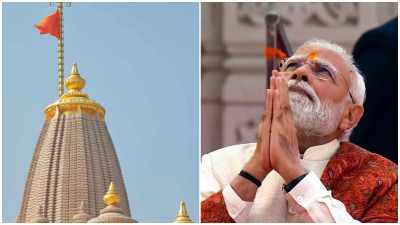In memory of soldiers who died, Mutiny Memorial tells story of 1857 Revolt
Constructed in 1863 on the site of the artillery unit known as Taylor’s Battery, which bore the brunt of rebel fire, the monument has an indifferent gothic design which resembles ‘a telescope badly drawn out’.
 The Mutiny Memorial is a four-tier structure rising from an octagonal base. Abhinav Saha
The Mutiny Memorial is a four-tier structure rising from an octagonal base. Abhinav Saha A few feet away from an Ashokan pillar, inscribed with Ashoka’s policy and Dharma in the Brahmi script, stands a tapering four-tier red sandstone structure rising from an octagonal base on the Northern Ridge. This is the Mutiny Memorial, built in the memory of those who had fought in the Delhi Field Force, both British and Indians, during the Revolt of 1857.
The structure is prolifically inscribed with written accounts of the revolt. The placard on the structure’s lowest tier read, “In Memory of the officers and soldiers, British and native of the Delhi Field Force, who were killed in action or died of wounds or disease between the 30th May and 20th September 1857.”
Constructed in 1863 on the site of the artillery unit known as Taylor’s Battery, which bore the brunt of rebel fire, the monument has an indifferent gothic design which resembles ‘a telescope badly drawn out’.
 Constructed in 1863 on the site of the artillery unit known as Taylor’s Battery, which bore the brunt of rebel fire, the monument has an indifferent gothic design (Source: ‘Commemorating and Remembering 1857: The Revolt in Delhi and its Afterlife’)
Constructed in 1863 on the site of the artillery unit known as Taylor’s Battery, which bore the brunt of rebel fire, the monument has an indifferent gothic design (Source: ‘Commemorating and Remembering 1857: The Revolt in Delhi and its Afterlife’)
Historians believe the arched marble-backed recesses, inset on all sides of the octagonal tower, were poorly executed and occasionally created out of three separate pieces of stone.
Speaking to The Indian Express, author and historian Swapna Liddle said, “It was built to honour those who fought from the British side during the Revolt of 1857 but later after Independence, particularly after 25 years, they re-dedicated it to the memory of those Indians who lost their lives fighting the British.”
Professor of history at Ashoka University and historian Nayanjot Lahiri, in her research paper, ‘Commemorating and Remembering 1857: The Revolt in Delhi and its Afterlife’, states: “On one hand, of the destruction, demolition and confiscation that took place in the city and also in some of Delhi’s villages, during and in the aftermath of the revolt. On the other hand, equally transforming was the British commemoration of their victory, which resulted in the construction of a memorialised landscape by them, around the graves of dead soldiers and the scenes of military action.”
 Historians also believe that in 1972, the government renamed the memorial to Ajitgarh which means ‘place of vanquished’ converting it into a memorial of Indian soldiers who lost their lives against the British. Historians also believe that in 1972, the government renamed the memorial to Ajitgarh which means ‘place of vanquished’ converting it into a memorial of Indian soldiers who lost their lives against the British. (Source: ‘Commemorating and Remembering 1857: The Revolt in Delhi and its Afterlife’)
Historians also believe that in 1972, the government renamed the memorial to Ajitgarh which means ‘place of vanquished’ converting it into a memorial of Indian soldiers who lost their lives against the British. Historians also believe that in 1972, the government renamed the memorial to Ajitgarh which means ‘place of vanquished’ converting it into a memorial of Indian soldiers who lost their lives against the British. (Source: ‘Commemorating and Remembering 1857: The Revolt in Delhi and its Afterlife’)
The article examines the physical impact of the revolt against British rule in India in one of the most crucial arenas of resistance — the Delhi region of north India.
According to Lahiri’s article, 25 years after India became independent, the structure was “converted” into a memorial as the inscriptions at the entrance of the monument inform us “for those martyrs who rose and fought against British during the 1857 AD”.
Historians also believe that in 1972, the government renamed the memorial to Ajitgarh which means ‘place of vanquished’ converting it into a memorial of Indian soldiers who lost their lives against the British.
Another plaque installed in 1972 by the government on the Mutiny Memorial points out that “the enemy of the inscriptions on this monument were those who rose against colonial rule and fought bravely for national liberation in 1857. In memory of the heroism of these immortal martyrs for Indian Freedom, this plaque was unveiled on the 25th anniversary of the nation’s attainment of freedom”.
Lahiri wrote, “To any visitor, these messages appear to be incongruous, minimalist gestures, aimed only at challenging the British perspective. There is no separate memorial to honour the rebels, no mention at all of those who lost their lives fighting the British, nor any attempt to highlight how the revolt tied up with the history of the Delhi region.”
Of the 1,029 army men who lost their lives, only 47 are specifically mentioned on the memorial. “Racial difference is inscribed into each of these categories; the casualties are subdivided into ‘European’ and ‘Native’ Even in death, English men were privileged over their racial ‘other’. The inscribed names are ‘European’, mainly those of dead officers. The fourteen ‘native’ officers who perished remain anonymous, reduced to a mere statistical detail in the monument’s inventory of casualties.” Lahiri wrote.







